Given how frightening and depressing hospitals can be for patients and our interest in the human-animal bond, we were thrilled to talk to experts Dr. Kurt Venator and Dr. Brent Bauer about how dogs are helping patients in hospitals at the Purina Better With Pets Summit .
New scientific evidence confirms that connecting pets with people can improve health and well-being for both. Based on this research, wonderful new programs are being implemented across the US.
Read: Purina Is Building A Better World For People and Pets
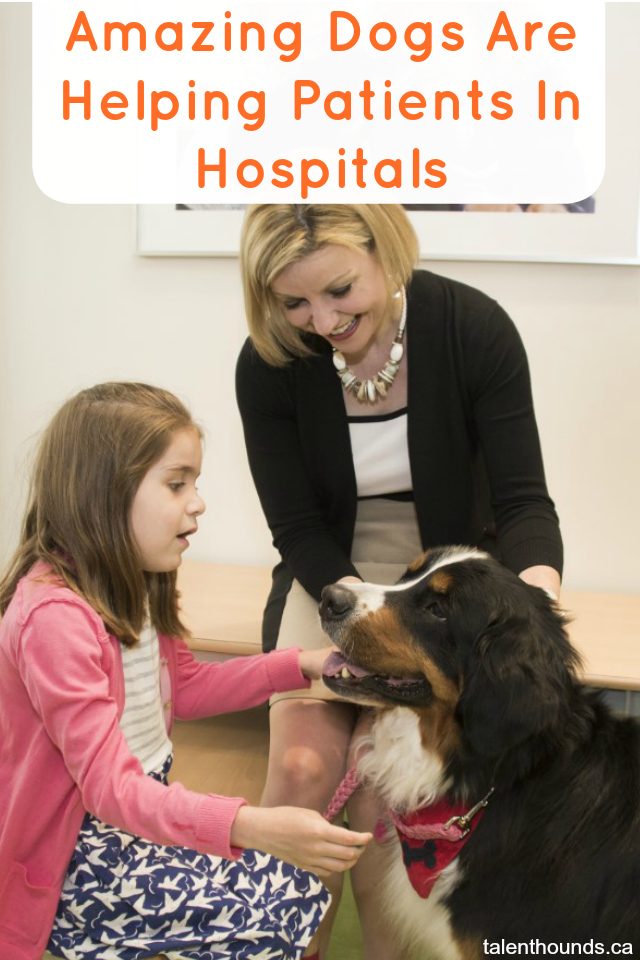
Service Dogs and Animal Therapy History
Dogs have long been trained to help and improve human lives. After World War 1, the first guide dog training schools were set up to help physically impaired returning veterans.
More recently, Dogs like NSD Chester and NSD Flicka have been trained to help children with autism and people with PTSD.
They can also be trained to detect when someone is about to have an epileptic attack or their blood sugar is off (see our Hero Dog Story for the diabetic twins). They have also been trained to smell cancer.
Animal therapy dates back to the 1940s when a tiny Yorkshire terrier named ”Smoky“ became the first recorded therapy dog we know of. Her legacy is just one of the countless inspiring stories to emerge in the years after World War II. When Smoky visited her wounded master, Corporal William Wynne, at a military hospital, nurses noticed something special. Her presence boosted the energy and lifted the spirits of Wynne and the other wounded men. Soon, Smoky had been nicknamed “The Yorkie Doodle Dandy” and was accompanying Dr. Charles Mayo (a founder of the famous Mayo Clinic) on rounds throughout the hospital.
A Japanese study found dog owners visited the doctor 30% less often than non-dog owners and often had lower cholesterol and blood pressure.
Various studies in the US, Germany, and U.K. have confirmed that when you are anxious your levels of cortisol, a stress hormone, increase. Patting a dog can often reduce them considerably.
Looking at and petting a dog can also help raise levels of endorphins, serotonin, and oxytocin that trigger positive feelings of well-being and happiness.
Mayo Clinic Study On Exactly How Dogs Area Helping Patients in Hospitals.
This year Purina announced it is teaming up with Mayo Clinic on a study measuring the benefits of animal assisted therapy as a way to reduce pain and depression while improving the quality of life in patients.
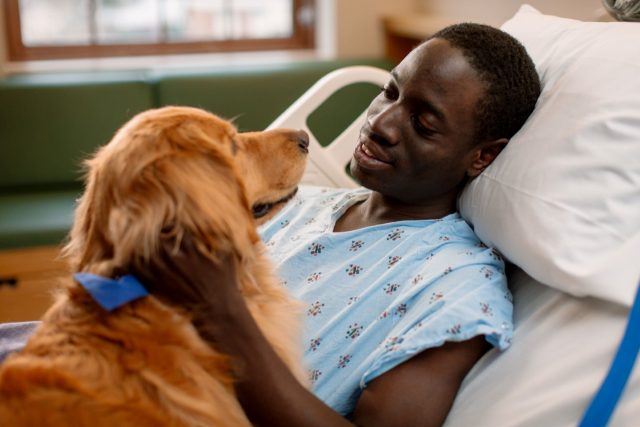
We spoke with Dr. Brent Bauer, a Mayo Clinic researcher with over 24 years of experience doing scientific evaluations of Complementary and Alternative Medicine (CAM) therapies. These treatments have been growing in popularity amongst the medical community, patients, and consumers.
Bauer founded the Integrative Medicine and Health Program at Mayo Clinic about 16 years ago. He is a member of numerous scientific review panels and is currently collaborating on over 20 studies evaluating CAM therapies. These therapies range from acupuncture, yoga, pets and meditation to valerian.
He is the medical director of Rejuvenate, the first spa at the Mayo Clinic for Innovation, which explores the impact of the indoor environment on wellness. His work has thrust him to the forefront of the conventional field of Integrative Medicine, which combines the best of conventional treatments with the best complementary therapies backed by evidence.
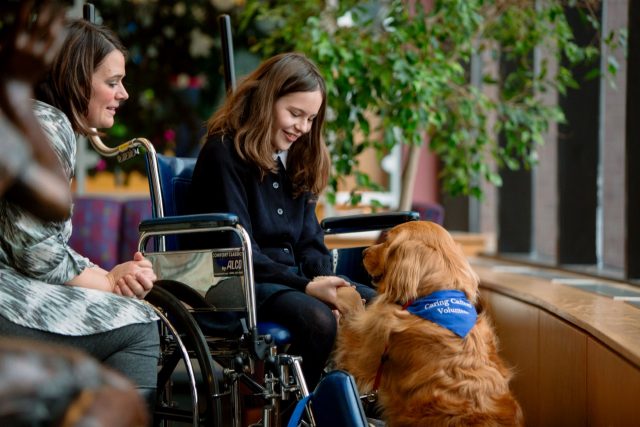
Research on Animal-Assisted Therapy Visits
Bauer began conducting many studies to prove the impact that animal-assisted therapy visits in hospitals had on a patient’s well-being.
The studies looked at:
- How does bringing a dog into a hospital room change that person’s day?
- How does that change their mood?
- How does that change their stress levels?
Of course, they found there were tremendous benefits. They now have more demand for pet visits than pets available.
“The number one thing when a pet comes into a room is we see the stress levels go down and you can assess that just by watching people. You can see their shoulders drop, you can see them take a deeper breath, and most people smile right away. You don’t need a lot of physiological markers to know that we’re having an impact.” -Brent Bauer
The study accessed things like blood pressure and heart rate variability which is a good marker for levels of stress. Some studies looked at cortisol, a stress hormone, by taking a little swab from the cheek and looking at how it goes down in response to a pet visit.

Animal-assisted therapy visits became so popular in the hospital they introduced 30-35 volunteer teams and about a year ago purchased Alta, a beautiful Golden Retriever who’s now an institutional dog for Mayo Clinic. She goes to work every day and travels around visiting the patients that volunteers don’t have a chance to get to.
“I think anyone who’s seen a pet or a dog come onto a hospital floor doubts the benefits. First of all, we see tremendous benefit for the staff because we can’t have Alta or one of our volunteer dogs walk down the hallway without 20 different nurses coming out of the rooms. They want to stop, just even for 2 minutes to pet the dog and cuddle the dog and you can see that their tightness and their stress melts away. We’re all stressed, we’re all working hard, it’s common to America. So I think just even having the staff benefit is huge. But where the real magic happens is when the dogs get in the rooms and the dogs seem to have an intuitive knowledge of what the patient needs. Sometimes all they need is someone to curl up on the bed with them and be quite and relax and bring attention down. Sometimes it’s more “hey I need to get up more and do more” and we’ll see the dog be beneficial for physical therapy.” – Brent Bauer
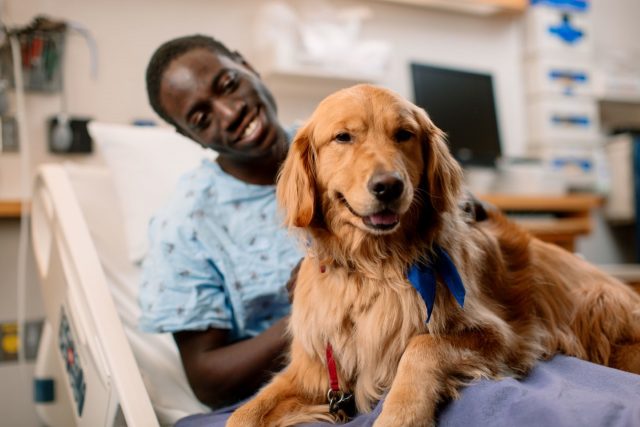
Edward Creagan, M.D., a Mayo Clinic oncologist, calls pets “a medication without side effects.”
Jessica Smidt is the coordinator of Mayo Clinic’s Caring Canine Therapy Dog Program. In the “In the Loop” blog, she says pet therapy offers something medicine perhaps can’t. Spending time with a dog “gives people a sense of normalcy,” says Smidt, who visits patients with Alta, Mayo’s first facility-based service dog. “Many of us consider our pets family,” she says, and “when people are in the hospital, they miss their pets.” That can be particularly true for some of Mayo’s youngest patients, where visits from therapy dogs are an especially welcome distraction. Some of the kids even collect calling cards that Mayo creates for its Caring Canines.
The dogs are used to aid in physical therapy by having patients naturally want to get up and pet or play with the dogs. Having a dog be there before a child goes to a procedure or before a person goes into something they are fearful about or worried about is also really beneficial.
“There’s a fair amount of research on what a dog can do with young children that have attention problems. We’re naturally keyed into nature and naturally want to bring our attention to what’s in front of us. It doesn’t mean it’s a magic cure for every patient with an attention problem, but it’s nice to have that extra tool in our tool kit.” – Brent Bauer
Dogs Are Making A Difference In Hospitals
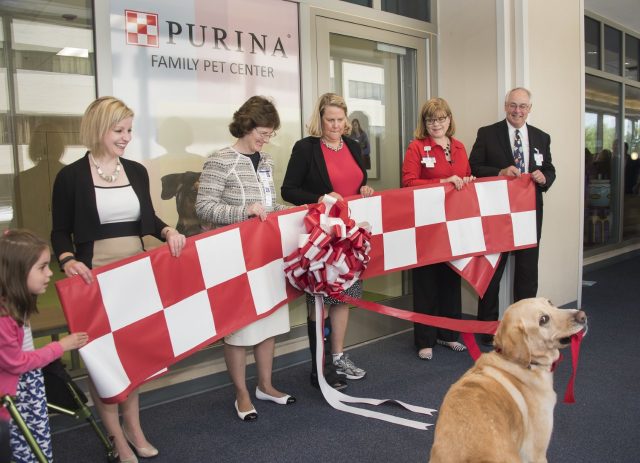
Following the trend of CAM therapies Purina partnered with Flip Becker, senior director with the St.Louis Children’s hospital to open the Purina Family Pet Center, which allows patients to bring their pets to the hospital for visits. While the number of therapy dogs in nursing homes and hospitals has been gaining popularity, it’s rare to have a care center that allows patients to visit with their own dogs. This special visiting time with family and their pets has a profound impact on the patients who are often homesick. During these visits, children are able to forget their troubles and play with their furry friend in a brand new private visiting space thanks to Purina’s generous help.
The goals of the Family Pet Center:
- Create a comfortable, safe and welcoming environment where patients and their families can reunite with the family pet while the child is in the hospital undergoing treatment.
- To bring joy and overall emotional well-being to children and their families through the therapeutic impact of personal pet interaction.
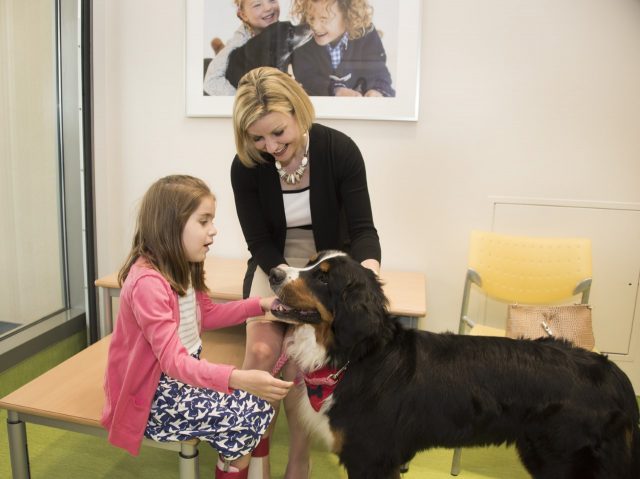
“At Purina, we believe that pets and people are better together, and our friends at St. Louis Children’s Hospital clearly share our belief,” said Nina Leigh Krueger, Purina president. “Our goal for the Purina Family Pet Center is to bring joy and comfort to children and their families by helping them reunite with their pets during their stay.”
A Therapeutic Friendship (Selah’s Story)
Roben Harris opened the session at the presentation on How Passion for Pets Builds a Better World by telling us the story of the therapeutic friendship between her daughter and her Labradoodle. Harris’s daughter Selah was born with Spina Bifida, a birth defect that affects about 1,500-2,000 children in the US each year.
Spina Bifida, is a neural tube defect that affects the spine when it’s being formed. Selah’s was high on her spine, effecting her 12th thoracic vertebrate. This has left her paraplegic. She can’t move or feel anything from her waist down and she has several other diagnoses’ that go along with it. Selah has been in and out of the St.Louis Children’s hospital where she has been treated 28 times for surgery in her short 11 and a half years. But this eleven-year-old girl stays positive thanks to the help of her best friend Labradoodle, Chocolate Chip Chewbacca Harris who makes visits while she’s in treatment and One of the most important things that Chip, the Harris family, and their friend’s pets do is that they come to Selah.

Thankfully the Purina Family Pet Center allows patients who stay for more than 7 days bring their dog to a nice space located beside the parking garage. The family pet enters through the parking garage and the patient comes down and enters from the hospital side and they get to enjoy some time together. It really helps bring that little bit of home into the hospital, which is something that parents are always trying to do. As a parent, Harris is always trying to bring connection because when Selah is in the hospital its easy for her to feel very left out.
You can find out more about Selah and her family on her YouTube Channel “Sit Down Comedy with Selah“.
Purina Is Making A Difference For Pets
Nestle Purina PetCare Company is a global leader in the pet care industry; promoting responsible pet care, community involvement, and the human-animal bond.
Thank you to Purina for helping make lives Better With Pets.

I’ve often thought about doing something like this with Penny…. be it at a hospital or nursing home.
I think service dogs should be allowed everywhere as they bring smiles, helps the patient and so much more, great article
I only knew about ervice cats for a long time! It’s great dogs are being allowed to help. This kind of thing needs serious funding as it makes everyone in a hospita, or healing environment, so much better.
What an amazing read! Thank you for sharing this with us! Keep up the awesome posts 🙂 Henry
I believe 100% that dogs or any pet for that matter, can make a huge difference in a persons life and their well being. I think it’s marvellous that more health care professions and institutions are seeing the benefit of this.
Animal-assisted therapy is so important. Not only do the people receiving the visits benefit, but the family members, staff and ourselves. Thanks for this post.
I sure hope that if I am ever hospitalized that some therapy dogs come to visit me!
The Family Pet Center is a really good idea. Dogs and children often have a really strong bond, being able to visit with each other probably helps the dog just as much as their human
Working in a large health system, I can vouch for the importance of these programs – Mattie participated for a long time and it was so rewarding to see him working with the children (who had cancer), it brightened their day (and lives)!
I am definitely a believer in the healing power of animals. I love the story of Chewy and Selah! Believe it or not, there’s actually an organization near us that uses miniature ponies as therapy animals with children with cancer. Pretty amazing.
Mr. N misses doing therapy work, I think. But unofficially he cheers up people on the street by doing tricks!
I got a little teary eyed reading about the Mayo clinic and therapy dogs. I wish every patient could be visited by a therapy dog (or cat if that’s the patient’s preference.)
These stories make my heart flutter. I used to do pet therapy with my first Cocker. I know that havign a dog by your side when you are in the hospital does wonders, too. We had Dexter in the hospital to see my spouse last year when she was ill. She came home the very next day 😉
I remember when Dex got to visit- such a boost at a very scary time. There is no doubt in my mind that dogs make a difference, especially your little guy.
Beautiful post. Animals are the best therapists. We were hoping to include NSD in our recent series. The timing was off but they are one of many amazing organizations whose work we look forward to highlighting. Thank you for sharing this uplifting post; I know I feel better for it.
Yes NSD do great work, especially in autism and PTSD.
Love this. I have an ESA. Without him I can’t fly. Thanks to him I have access to the world again. That is huge.
I think this is wonderful. I keep looking for therapy dogs in the hospitals when I visit with my parents.